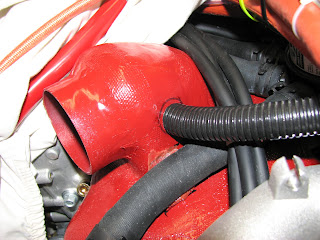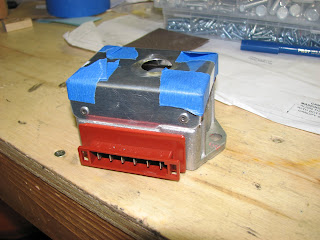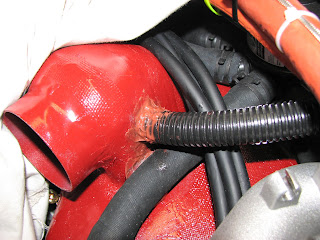The last part of the mechanical lighting installation was to add an air scoop to the Ducati voltage regulator. There is more to this section but this does not affect any installation of sorts but only modification to the weight and balance and additional paperwork for the registration and certification.
After deburring the parts, I did a trial fit on the installed regulator.
Then I marked the opening on the fiberglass baffle where the hose would connect to later.
This hole is pretty inaccessible, so I used a #12 pilot drill bit and opened it up with the Dremel before I used the step drill bit to come up with a clean hole. The step drill bit was turned by hand and a wrench, which took a while but worked ok.
I also came up with a spiffy way of keeping debris out of the baffled area. This is my way of a vacuum hook up t the baffle.
The 3/4" is the perfect size for the hose.
I removed the regulator and got ready to match drill the cooling fins with the air scoop cover.
A clamp kept the cover in place during match-drilling.
I filled the corners of the cover from the inside with RTV and used blue tape to ensure it wouldn't squeeze out.
Then I riveted the cover on. I also applied a thin coat of thermal compound along the
fins where they touch the cover to better the heat transfer and enlarge the cooling surface. The regulator is known to overheat and the Tucson heat won't help that either.
Before installing the regulator on the firewall shelf, I applied RTV to the hose/surface connections and let it settle. Otherwise the hose would pull itself out of the regulator cover when applying a slight pull to the hose.
The next day the RTV had settled and was holding the hose in place so I could finish the installation and tie-wrap the hose in place.
Again, I applied some thermal compound to the flanges that connect the regulator mechanically to the shelf. It's not much surface contact but it might help to get the heat away. What I do not understand in this layout is that the water radiator is routing warm air towards the regulator in this setup. I believe a deflector shield in front of it could help to avoid this.
This was the last step in Section 40 until the paperwork has to be done.
Monday, July 30, 2012
Subscribe to:
Post Comments (Atom)















No comments:
Post a Comment